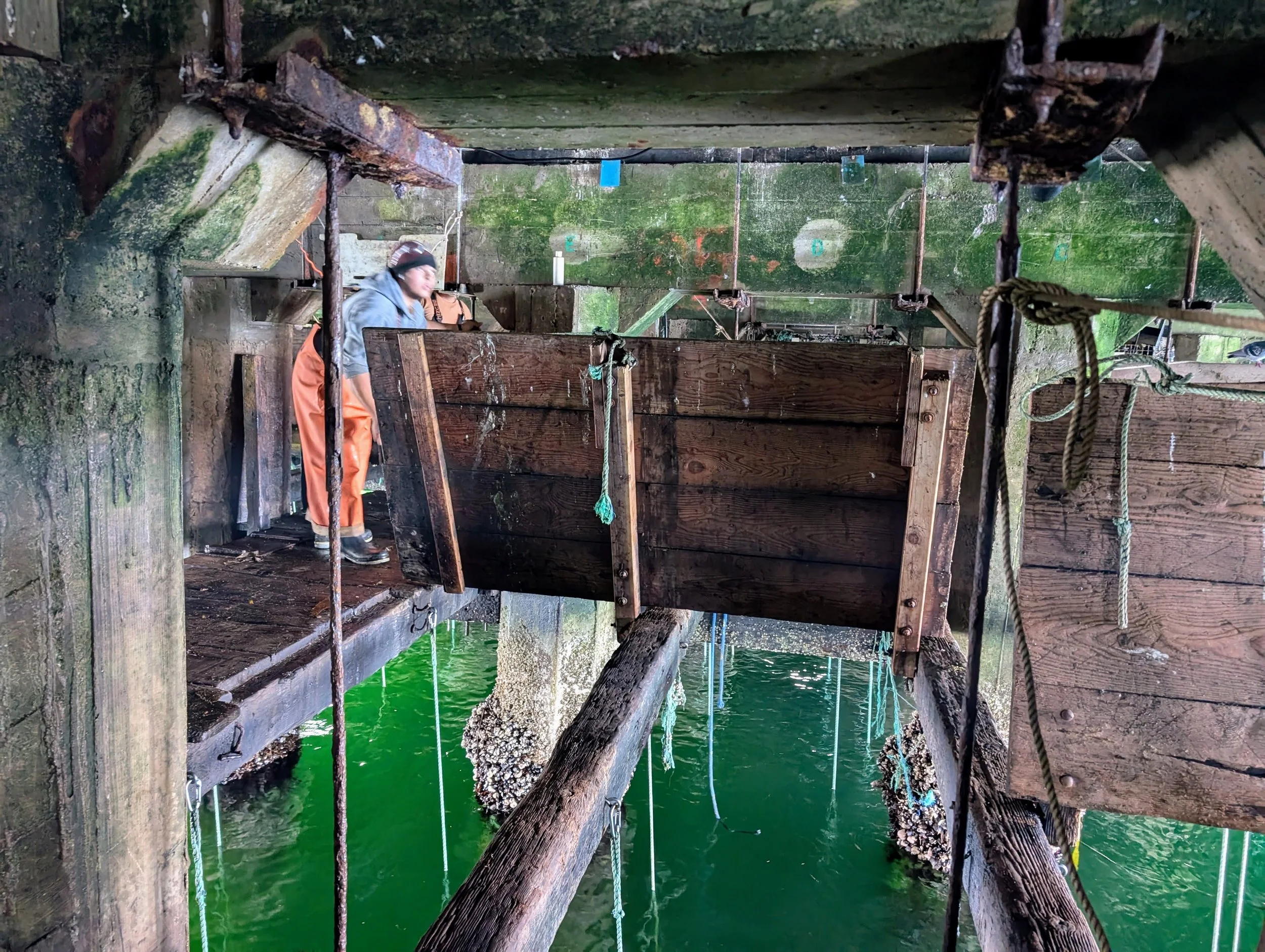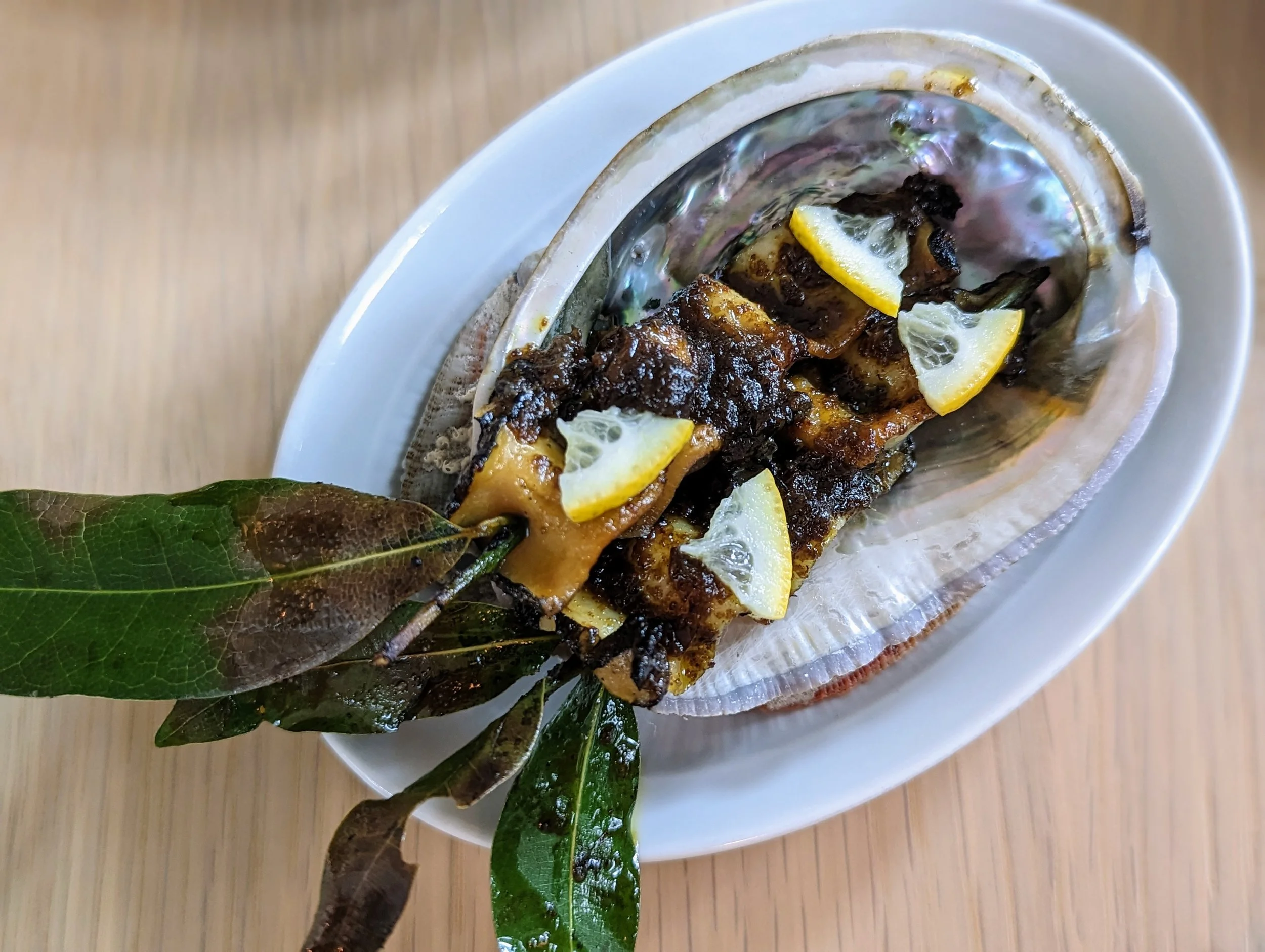Monterey Bay Semi-Secret Seafood Star: Abalone
By Mark C Anderson, October 7, 2025
Baby abalone shells on sale at Monterey Abalone Company (MAC)
Photo by Mark Anderson
Abalone made Monterey Bay what it is today. Full stop.
If that seems like a mouthful, fair enough. It’s also true.
Don’t take my word for it, though. Fourth-generation Californian Tim Thomas, a historian and Monterey waterfront tour guide, has been researching abalone’s impact on the area for more than 40 years.
“Honestly, without abalone, I think the area would be very different,” he says.
He notes abundant wild abalone were an essential food and trading currency for the first peoples of this area, the Rumsen Ohlone. And, it was abalone that first drew Chinese and then Japanese immigrants to these shores. That led to the discovery of an abundant salmon harvest, which in turn triggered other waves of immigrants, which led to the discovery of the sardine fishery, which cultivated the emergence of Cannery Row.
The Japanese provided early scuba dive technology, cutting-edge boat-maintenance knowledge and clever techniques to keep seafood fresh, helping Monterey’s seafood production game to evolve faster than most places on the planet.
“All the connections come back to abalone,” Thomas told me back in 2014. “It all starts with abalone. Five thousand years ago, the [Rumsen] people gathered it. It was a huge part of their life.”
I talked with Thomas in the summer of 2014 because he had just published The Abalone King of Monterey: “Pop” Ernest Doelter, pioneering Japanese fishermen and the culinary classic that saved an industry.
In the 144-page book, Thomas describes how a German immigrant revolutionized the way people experienced abalone.
Freshly harvested live abalone
Photo by Mark Anderson
The year was 1908, when virtually all of the abalone harvested from Monterey Bay was shipped to Japan.
“Pop” Ernest Doelter changed that with his Pop Ernest’s Sea Food Restaurant shop on Alvarado Street in downtown Monterey and, later, Fisherman’s Wharf.
Doelter’s new abalone recipe—pounding the meaty foot of the big marine snail, egg washing it, rolling it in cracker crumbs and frying it in olive oil—borrowed from his native country’s approach to cooking weinerschnitzel.
It proved so popular his restaurant became famous statewide, drawing still more visitors to the area.
“People came from all over to eat his delicious new food sensation, ‘abalone,’” Thomas writes. “The demand was so big, and the restaurant so crowded, that all five of Chef Doelter’s children were put to work serving abalone to patrons.”
He adds that abalone enjoys many pseudonyms: muttonfish, Venus’s ears, ear shells, awabi (in Japan) and orejas del mar (in Mexico). But its truest title hails from right here.
“The name abalone comes from Monterey, and it originated with the Rumsiens, the native people of Monterey, who had a word for the red abalone, the largest of the abalone and the [predominant] abalone in the Monterey Bay,” Thomas writes. “That word is aulun. Early Spanish settlers called it abulon, based on the Rumsien word, and linguists today trace the word abalone all the way back to that word, aulun, that started in Monterey several thousand years ago.”
Rumsen Ohlone dancers at the Monterey Abalone Festival
A decade after publishing the book, and four decades of research, Thomas sounds as certain as ever of the conclusion he’s reached. And maybe others are catching on, if the debut of the Monterey Abalone Festival this summer—filled with walking tours, films, dance, lectures, shell sales and talks from Thomas himself—is any indication.
“The abalone fishery is most important in the history of California,” he says. “Maybe not economically, but culturally.”
The irony then, is that due to severe population declines of wild abalone (mostly red and white abalone)—thanks to a mix of overfishing and disease—commercial abalone fisheries have been closed for a very long time, and recreational harvest closed since 2018. So while it is illegal to harvest abalone from the wild, we are fortunate to have one of the few remaining abalone farms right here in Monterey Bay.
•••
A peek at the flooring at MAC’s below-pier farm that retracts to prevent sea lions from taking up residence
Photo by Mark Anderson
Descending the handmade ladder through the trapdoor in the floor at Monterey Abalone Company (MAC) can feel like traversing a portal to another world.
Down below, underneath MAC’s industrial shopfront on the end of Monterey’s Wharf 2, refrigerator-sized sea lions lounge on nearby girders. Shafts of light slice between low ceilings and slippery wooden decks. And MAC co-founder Art Seavey and his team sink big rectangular cages into the ocean.
Those cages are full of plastic panels dotted with various sizes of abalone, which the staff feeds foraged kelp while waiting until they’re fat enough to ship to restaurants and eaters around the county.
MAC is one of just two abalone farms currently operational in California, and Seavey is well familiar with its semi-secret status, even after raising abalone there for more than 30 years.
“We still get locals who say, ‘I didn’t realize you were here!’” he says.
But that keeps with the theme of abalone’s sneaky big legacy. And just as few recognize abalone’s impact on the community, they might not know how it helped earn the area’s only Michelin stars, either.
•••
As Library and Museums Director for the City of Monterey, Brian Edwards’s job requires a handle on history.
So it’s telling to hear him gauge abalone’s impact.
“Abalone drew attention to Monterey as a fishing industry, which brought in the immigrants who in turn brought in restaurants and culture, and led the charge in creating a farming community, and in inspiring a lot of cultures to learn from and interact with one another,” he says. “Abalone was the driver.”
Abalone us their muscular foot for movement and attachment to hard surfaces; they breath and expel waste through respiratory holes on their shells
Photo by Mark Anderson
He is quick to offer two of his favorite fun facts.
“I like that ‘gastropod’ means ‘stomach-foot’ which is just not appetizing,” he says. “Abalone…is a much more beautiful word.”
His second nugget gets at abalone’s outsized impact, reaching way back to its early days as a staple of the native Rumsien diet—and barter economy.
“The other thing that is of interest to me is that the abalone shell can be found in indigenous culture throughout the United States and Canada, but it comes from [the West] Coastline,” he says. “So we know that people traveled and traded for it, often seeking the beauty or symbolism of the shell.”
On that note, the very definition of a two-star Michelin restaurant is a place that inspires travel. “Worth a detour” is the technical language the revered dining guide uses.
At two-star Aubergine in Carmel—the only two-star spot in the greater Monterey Bay Area—abalone represents one of Executive Chef Justin Cogley’s favorite things to work with, and makes him one of Monterey Abalone Company’s most loyal customers.
It appears in dishes a little more involved than Pop’s, including one past preparation where he simmered the sea snail in seawater and served it with Castroville artichokes and seaweed, and another with which he layered abalone, oyster, pickled sea beans and wild sea lettuce on a cake made with braised pig’s tail.
He’s not alone in leveraging abalone to delicious effect.
At Cannery Row’s Sardine Factory, the area’s most storied restaurant, the most famous dish is abalone bisque, which staff will remind you was served at the White House to celebrate President Ronald Reagan’s inauguration.
The spellbinding abalone skewers at Chez Noir in Carmel
Photo by Mark Anderson
And at Chez Noir, who earned a Michelin star about as fast as any new California restaurant ever has, their thin-sliced, bay-leaf skewered seared abalone was described as one of the Michelin inspectors’ favorite dishes in the entire state and its estimated 100,000 restaurants.
So while it’s perfectly OK to admire abalone solely for the opalescent interior of their shells, real abalone fans know it’s a lot more than a pretty ear of the sea. It’s a foundation of Monterey Bay identity.






